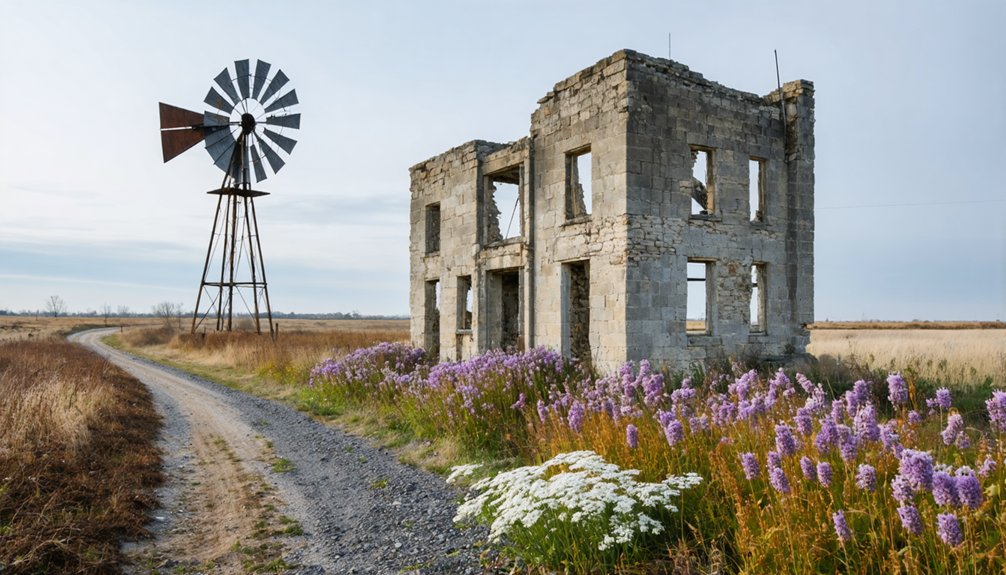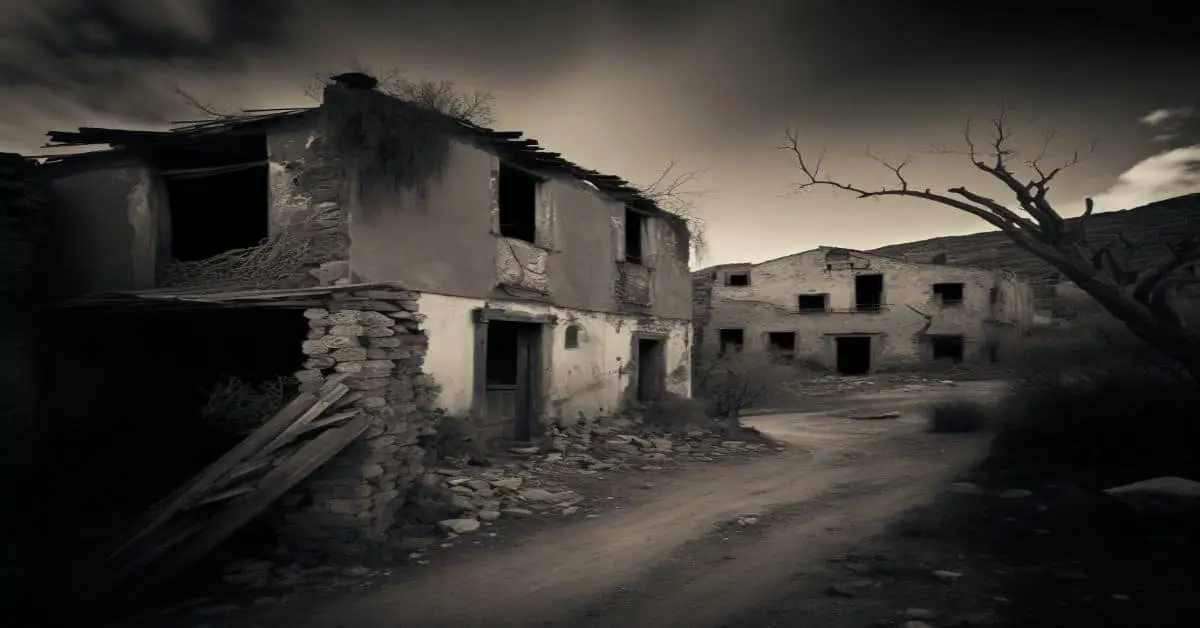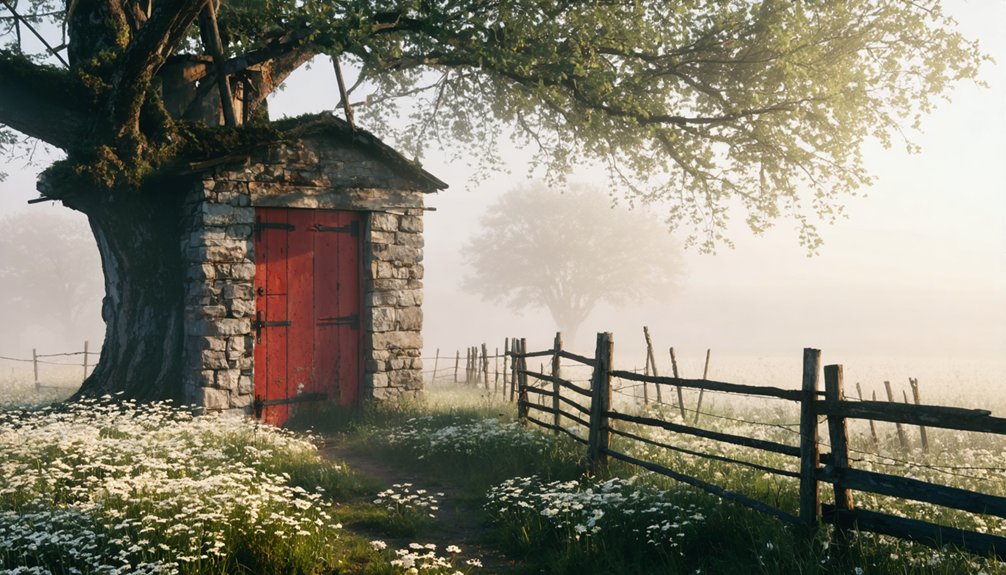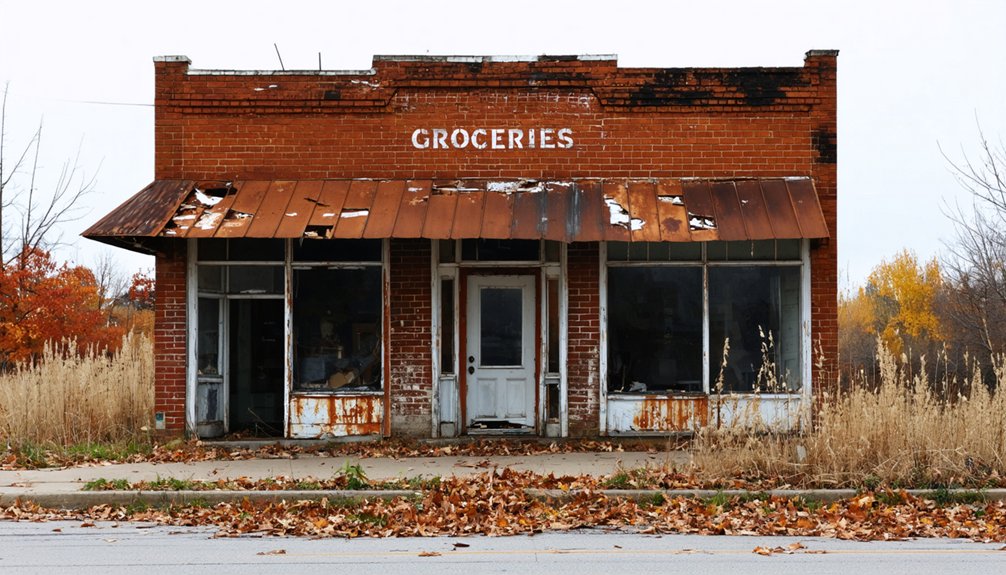You’ll find Dudley, Iowa at 41°05′16″N and 92°35′31″W in Wapello County, where it once thrived as a small farming community established in 1843. Named after early landowners, the settlement peaked at 64 residents in 1925 before declining sharply after 1940. Today, this ghost town‘s only remnant is a humorous sign claiming “Population 12 and God only knows how many dogs and cats.” The story behind Dudley’s transformation from bustling agricultural hub to abandoned prairie holds fascinating insights into Iowa’s rural past.
Key Takeaways
- Dudley, established in 1843 in Wapello County, Iowa, is now a ghost town with only foundations and remnants remaining.
- The town’s population peaked at 64 residents in 1925 before declining sharply after 1940 due to agricultural economic pressures.
- A humorous sign remains, stating “Population 12 and God only knows how many dogs and cats.”
- The settlement never developed significant infrastructure, operating without stores and only gaining a post office by early 1900s.
- Agricultural dependence and lack of economic diversification led to the town’s abandonment as younger residents sought opportunities elsewhere.
Early Settlement and Geographic Location
While Wapello County’s establishment in 1843 laid the groundwork for regional development, Dudley emerged as a small settlement in northwestern Wapello County, Iowa, positioned at 41°05′16″N latitude and 92°35′31″W longitude.
You’ll find this former community nestled at an elevation of 692 feet above sea level, surrounded by the region’s characteristic rolling plains and wooded areas. Similar to the historic town of Duddan Leah in England, this settlement derived its name from early landowners.
The settlement patterns followed typical mid-19th century Iowa development, with early pioneers including the notable Dudley family establishing roots here. Like the Connecticut settlement that came before it, the town operated without any stores or schools, requiring residents to travel to nearby communities for basic provisions. By the early 1900s, you’d have found a functioning post office serving the agricultural community, marking Dudley’s peak as a frontier town.
Early settlers, led by the Dudley clan, shaped this Iowa frontier town that flourished briefly with its own post office.
The geographic features that attracted settlers included fertile farmland and access to the Des Moines River, though these weren’t enough to guarantee the town’s longevity.
Population Changes Through the Decades
Population records from the early 1900s paint a picture of Dudley as a modest rural settlement, beginning with 55 residents in 1902 and growing slightly to 64 by 1925.
Community dynamics remained stable through the mid-20th century, with the population holding steady at 64 in 1940.
You’ll find that demographic trends took a dramatic downturn after 1940, as Dudley experienced severe depopulation.
Like England’s Dudley which became an industrial center in the 19th century, this Iowa town never achieved similar economic growth or development.
Today, a sign at the town site reveals just how far the community has fallen, stating “Population 12 and God only knows how many dogs and cats.”
While Wapello County’s population grew until 1950, Dudley’s decline mirrors the fate of many small Iowa settlements that couldn’t sustain their populations as rural communities emptied out across the state.
The county’s overall demographics show a current population of 35,437 residents, highlighting the stark contrast between Dudley’s decline and the broader region’s stability.
Life in Early 20th Century Dudley
Life in early 20th century Dudley revolved around a close-knit agricultural community where residents wore multiple hats to keep their town functioning. You’d find local preachers doubling as newspaper writers, and teachers serving as religious leaders, demonstrating the versatility required in a town of just 55-64 residents.
Despite facing schooling challenges in primitive cabins during winter months, families persevered to educate their children. Religious gatherings, held primarily in homes, served as both spiritual and social cornerstones. The town’s establishment came shortly after Chief Wapello’s death in 1842, during a period of significant regional change.
Your daily life would’ve centered around farming, with difficult prairie cultivation and limited mill access testing your self-reliance. The post office, operating from 1908 through 1920, provided your essential link to the outside world, while primitive roads connected you to neighboring communities like Ottumwa for larger trading needs.
Factors Behind the Town’s Decline
As agriculture began to falter in the early 20th century, Dudley faced mounting economic pressures that would ultimately seal its fate. The town’s heavy reliance on farming left it particularly vulnerable to agricultural market fluctuations, exposing critical economic vulnerabilities. Similar to how frequent flooding devastated communities like Iowaville, natural disasters wreaked havoc on Dudley’s agricultural economy.
You’ll find that Dudley’s lack of economic diversification made it impossible to sustain itself when crop prices declined. Without access to high-speed internet and basic amenities that help towns survive today, the isolated community struggled to maintain its economic footing.
Dramatic demographic shifts accelerated the town’s decline, as younger residents moved to larger cities seeking better opportunities. Without a stable workforce and facing limited access to capital, local businesses struggled to survive.
The town’s aging infrastructure and inadequate healthcare services made it increasingly difficult to attract new residents. These challenges, combined with deteriorating social connections and limited government support, created a downward spiral from which Dudley couldn’t recover.
Present-Day Ghost Town Status
Today, you’ll find virtually no trace of life in Dudley, Iowa, a stark indication to its ghost town status in Wapello County.
Only scattered building foundations and remnants of the old post office site hint at the community that once peaked at 64 residents in 1940. Like its Connecticut counterpart, the area is now marked by cellar holes visible among the overgrowth. Much like the original Dudleytown’s harsh economic conditions, poor resources and isolation contributed to its eventual abandonment. A solitary sign humorously declares “Population 12 and God only knows how many dogs and cats,” though even this count vastly overestimates current occupancy.
A lone sign mocks Dudley’s emptiness, claiming twelve souls remain where only crumbling foundations mark a ghostly past.
Current accessibility challenges make exploring Dudley difficult, as the site likely sits on private land with no maintained infrastructure or authorized access.
While the town maintains its place in cultural memory preservation through historical records and ghost town listings, you won’t find any tourist amenities or organized tours.
The land has largely returned to nature, with no active preservation efforts in place.
Frequently Asked Questions
Were There Any Notable Businesses or Industries Operating in Dudley’s Prime Years?
You’d have found basic Dudley businesses like general stores, a post office, and agricultural operations. Small-scale industries included local trade services, farming enterprises, and possibly some light manufacturing workshops.
What Happened to the Original Buildings and Homes of Dudley’s Residents?
Like ghosts fading into mist, your ancestors’ abandoned structures vanished after the devastating 1851 flood, with most materials either washed away or repurposed for rebuilding in Carlisle’s new location.
Did Any Famous or Historically Significant People Come From Dudley?
You won’t find any famous residents directly from Dudley itself. While Wapello County had historically significant pioneers like Charles Dudley, the tiny town’s small population never produced widely recognized figures.
What Was the Primary Source of Employment for Dudley Residents?
Like most folks punching the clock back then, you’d find Dudley residents working the land – agricultural employment was their bread and butter, not mining activities that some neighboring towns relied on.
Were There Any Schools or Churches Established in Dudley?
You won’t find specific records of church significance or school history in Dudley, though it’s likely, like other small Iowa towns, that these institutions existed as community centers.
References
- https://en.wikipedia.org/wiki/Dudley
- https://www.wikiwand.com/en/articles/Dudley
- https://kids.kiddle.co/List_of_ghost_towns_in_Iowa
- https://www.wapellocounty.org/about/
- https://ia801307.us.archive.org/34/items/historyofwapello02wate/historyofwapello02wate.pdf
- https://pubs.lib.uiowa.edu/annals-of-iowa/article/id/13466/download/pdf/
- https://pubs.lib.uiowa.edu/annals-of-iowa/article/id/13329/download/pdf/
- https://en.wikipedia.org/wiki/List_of_ghost_towns_in_Iowa
- https://www.americanhauntingsink.com/dudleytown
- https://en.wikipedia.org/wiki/Wapello_County



